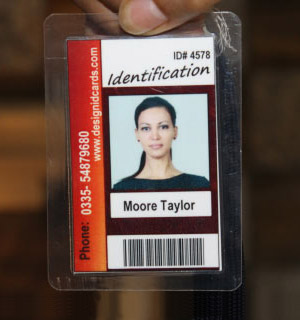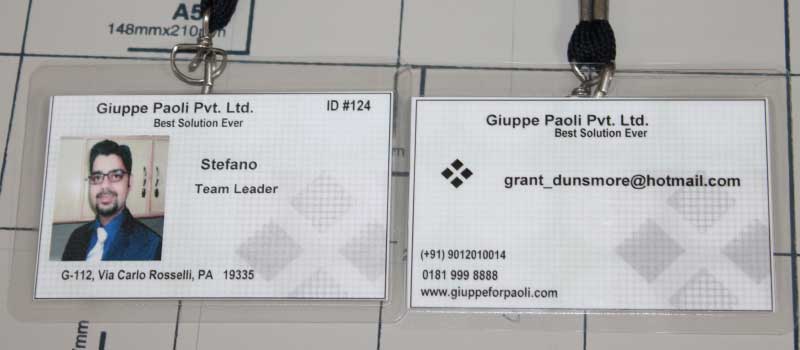Features and Key Components of ID Card Maker
Here are the key components and features typically associated with an ID card maker:

-
Design Interface:
ID card makers usually provide a user-friendly design interface that allows users to create customized card layouts. This interface often includes tools for adding text, images, logos, barcodes, and other graphic elements. Users can choose from pre-designed templates or create their own designs.
-
Data Capture:
ID card makers can integrate with various data sources, such as databases or spreadsheets, to capture information for the ID cards. This enables efficient data entry and minimizes errors. Users can import data or manually input it into the system.
-
Printing and Card Production:
Once the design and data entry are complete, an ID card maker facilitates the printing process. It can be integrated with dedicated card printers to produce high-quality ID cards on PVC or plastic cards. The software controls the printing settings, including card size, orientation, and printing options (e.g., single-sided or double-sided printing).
-
Photo Capture and Editing:
An ID card maker often includes features for capturing or importing photographs of individuals. It may provide basic editing tools to adjust the photo's size, brightness, or crop it to fit the ID card design.
-
Barcode and Magnetic Stripe Encoding:
Many ID card makers support the encoding of barcodes or magnetic stripes on the cards. This allows for additional data to be stored on the card, such as identification numbers or access permissions.
-
Security Features:
ID card makers often include features to enhance the security of the identification cards. These may include holographic overlays, UV printing, watermarks, or other anti-counterfeiting measures. Such features help deter fraudulent replication of the cards.
-
Database Management:
Some ID card makers offer database management capabilities to store and manage the cardholder information. This allows for easy retrieval and updating of data, especially in business organizations with a large number of ID cardholders.
ID card maker simplifies the entire process of designing, encoding, and producing ID cards. It provides a comprehensive solution to create professional-looking identification cards while incorporating security features to prevent tampering or forgery. Whether used by businesses, educational institutions, government agencies, or other organizations, ID card makers streamline the production of ID cards and contribute to effective identity management.
Working of ID Card Maker
An ID card maker is a device or software that is used to create identification cards for individuals. It typically involves a combination of hardware and software components to design and produce the ID cards. Here's a detailed explanation of how an ID card maker works:
-
Step 1Designing the ID Card:
The first step is to design the ID card template. This is usually done using specialized software that allows you to create a layout for the ID card. The software provides tools for adding text, images, logos, and other design elements to the card. You can customize the card's appearance according to your requirements, such as choosing colors, fonts, and sizes.
-
Step 2Capturing Personal Information:
Once the card template is created, the next step is to gather the necessary personal information for each ID card. This information may include the individual's name, photo, signature, identification number, job title, department, etc. The ID card maker software usually provides input fields or a database where you can enter or import this information.
-
Step 3Photo Capture:
To include a photo on the ID card, the ID card maker typically offers options for capturing or importing images or photos. Some ID card makers have built-in cameras that allow you to take a photo of the individual directly from the device. Alternatively, you can import photos from a digital camera, scanner, or existing image files in the system.
-
Step 4Encoding Data (Optional):
In some cases, ID cards may require additional features such as barcodes, magnetic stripes, or RFID chips for encoding data. These features enable the card to store and retrieve information when scanned or swiped. If needed, the ID card maker software can provide tools to encode data onto the card, ensuring that the necessary hardware components are compatible.
-
Step 5Printing the ID Card:
Once the design and personal information are finalized, the ID card maker proceeds to the printing stage. The device may have an integrated card printer or connect to an external printer. The printer uses PVC cards specifically designed for ID cards. It applies ink or thermal transfer ribbons to print the cards, including the individual's information, photo, and any encoded data.
-
Step 6Lamination and Finishing
(Optional):
For added durability and protection, ID cards can be laminated. Some ID card makers include a laminating module that applies a thin layer of protective material over the printed card. This helps prevent wear and tear, as well as tampering with the card's content. After lamination, the ID card maker may offer options for cutting the cards to the desired size and shape.
-
Step 7Database Management:
To keep track of ID card issuance and manage cardholder information, ID card maker software often includes a database component. This allows you to store and retrieve data associated with each ID card. You can search, update, and manage records in the database, making it easier to issue, reissue, or revoke ID cards when necessary.

It's important to note that the specific functionalities and features of an ID card maker may vary depending on the model and software being used. Some ID card makers are standalone devices with built-in printers, while others may require a computer or mobile device to operate. Additionally, there are also online ID card maker platforms that provide similar functionalities through a web-based interface, allowing you to design and print ID cards remotely.
Benefits of Using an ID Card Maker
Using an ID card maker offers several benefits, both for individuals and organizations. Here are the key advantages of utilizing an ID card maker:
-
Enhanced Security:
ID card makers allow you to incorporate security features into the ID cards, such as holograms, barcodes, magnetic stripes, or RFID chips. These features help prevent counterfeiting and unauthorized duplication of the ID cards. They also enable quick and accurate verification of the cardholder's identity, enhancing overall security measures.
-
Customization:
An ID card maker gives you the flexibility to design and customize ID cards according to your specific requirements. You can include organization logos, unique branding elements, and personalized designs. This customization enables you to create professional-looking ID cards that align with your organization's identity and image.
-
Efficient Identification Process:
With ID cards readily available, the identification process becomes more streamlined and efficient. ID cards provide a visual representation of the cardholder's identity, making it easier for security personnel, employees, or customers to recognize individuals quickly. This reduces the time and effort spent on verifying identities through other means, enhancing overall operational efficiency.
-
Improved Access Control:
ID cards can serve as access control tools, granting or restricting entry to specific areas or resources within an organization. By integrating ID card maker software with access control systems, you can program the ID cards to allow or deny access based on predefined rules. This helps ensure that only authorized personnel can enter restricted areas, increasing security and preventing unauthorized access.
-
Employee Accountability:
ID cards can aid in monitoring and tracking employee activities within an organization. By issuing ID cards to employees, you can easily identify individuals and associate their actions with specific events or transactions. This promotes accountability and discourages misconduct, as employees are aware that their actions can be traced back to them through their ID cards.
-
Efficient Data Management:
An ID card maker often includes a database component that allows you to manage cardholder information efficiently. This database can store and retrieve data associated with each ID card, such as employee details, access privileges, or other information. It simplifies the management of ID card issuance, updates, and revocation, as well as facilitates record-keeping and reporting processes.
-
Professional Image:
ID cards contribute to projecting a professional image for an organization. They create a sense of unity and belonging among employees and can be used as a visual representation of the organization's values and standards. Well-designed and professionally printed ID cards enhance the overall impression of your organization, both internally and externally.
-
Enhanced Safety:
In certain environments, such as construction sites or industrial facilities, ID cards can include additional safety features. For example, they can display emergency contact information or indicate special training or certifications that employees possess. This promotes a safer work environment and enables prompt action during emergencies.
Using an ID card maker offers numerous advantages, including improved security, customization options, streamlined identification processes, access control, employee accountability, efficient data management, professional image, and enhanced safety. These benefits make ID card makers an essential tool for various organizations, businesses, educational institutions, and government agencies.